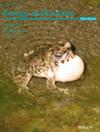巴西Caatinga种群中红尾蟒蛇(鳞目:蟒蛇科)的硬交配聚集作为多夫制的证据
IF 2.3
2区 生物学
Q2 ECOLOGY
引用次数: 0
摘要
本研究报告了巴西卡廷加一条雌性蟒蛇与五只雄性蟒蛇的生殖聚集。这一观察结果强化了一妻多夫制的证据,即体型较大的雌性与不同的雄性交配。我们的记录突出了性别大小二态性对聚集体形成的影响。本文章由计算机程序翻译,如有差异,请以英文原文为准。
Hard Mating Aggregation as Evidence of Polyandry in the Red-Tailed Boa, Boa constrictor (Squamata: Boidae), in a Brazilian Caatinga Population
This study reports a reproductive aggregation of a female Boa constrictor with five males in the Brazilian Caatinga. The observation reinforces the evidence of a polyandrous system, favoring larger females that copulate with different males. Our record highlights the influence of sexual size dimorphism in the formation of aggregations.
求助全文
通过发布文献求助,成功后即可免费获取论文全文。
去求助
来源期刊

Ecology and Evolution
ECOLOGY-
CiteScore
4.40
自引率
3.80%
发文量
1027
审稿时长
3-6 weeks
期刊介绍:
Ecology and Evolution is the peer reviewed journal for rapid dissemination of research in all areas of ecology, evolution and conservation science. The journal gives priority to quality research reports, theoretical or empirical, that develop our understanding of organisms and their diversity, interactions between them, and the natural environment.
Ecology and Evolution gives prompt and equal consideration to papers reporting theoretical, experimental, applied and descriptive work in terrestrial and aquatic environments. The journal will consider submissions across taxa in areas including but not limited to micro and macro ecological and evolutionary processes, characteristics of and interactions between individuals, populations, communities and the environment, physiological responses to environmental change, population genetics and phylogenetics, relatedness and kin selection, life histories, systematics and taxonomy, conservation genetics, extinction, speciation, adaption, behaviour, biodiversity, species abundance, macroecology, population and ecosystem dynamics, and conservation policy.
 求助内容:
求助内容: 应助结果提醒方式:
应助结果提醒方式:


